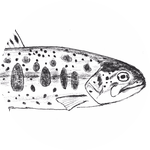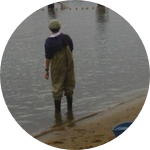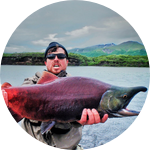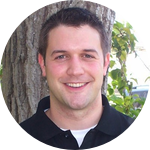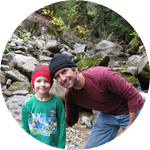Project Results
This funding allowed Tommaso and myself to build connections, including adding a great new collaborator in Jorge Nunes, that would have been impossible without a face-to-face meeting. My trip to the Brazilian Ichthyological Society meeting in Porto Seguro forged new relationships and spurring ideas for our future tarpon research. In São Luis, and in Belém, we learned more about the state of accidental sawfish catches and the black market for their rostrum. We able to collect a few sawfish samples fwhile I was there but most exciting , Jorge has identified another researcher willing to let us use their trove of nearly 100 sawfish rostra for analysis, which gives us a great start toward understanding sawfish movement and ecology.
About This Project
Amazonian catfish make the longest freshwater migration in the world (5,000km). Dams being built could block this migration before we can even understand it completely. Similarly, largetooth sawfish make upriver movements from the Atlantic ocean but we do not know why. We have published one paper using isotopic tracers from fish earbones to reconstruct details of catfish migration and propose to expand our work and to include sawfish, another endangered megafish, in our isotopic migration study.
Ask the Scientists
Join The DiscussionWhat is the context of this research?
Amazonian goliath catfish make one of the longest migrations on earth, from the Amazon estuary to the Andes foothills. This is as long as a road trip from Seattle to Miami, via Chicago, yet we know very little about how they make this trip. Dams are being built in the headwaters of many Amazon tributaries that could block this migration, and the species are already overfished.
Sawfish, related to sharks and rays, are listed as Critically Endangered worldwide. In the lower Amazon River, sawfish are often caught accidentally in fishing nets. Aside from their decline, very little is known about the ecology of these species.
Like megafishes worldwide, the long distance movements of both goliath catfish and sawfish make them particularly vulnerable yet we know very little about them.
What is the significance of this project?
Understanding the details of catfish and sawfish migrations are vitally important for Amazon conservation and its fishing economy. We need only look to the story of salmon to see how dams and overfishing might affect these catfish. Sawfish, despite being critically endangered, lack almost all understanding of their movements.
Luckily, modern chemistry has given ecologists incredible tools to understand these types of migrations. Using the chemistry trapped in the hard parts of fish (sawfish teeth or catfish ear bones) we can reconstruct with incredible precision the movements of individual fish. This data can help direct conservation strategies.
We have proven this is possible in the Amazon and further research will help us to understand how best to conserve these migrations in the future.
What are the goals of the project?
The best conservation strategies take into account the natural variation in migration within the population We currently have very little understanding of this for either species. Chemical analysis of the movements of many fish help us build an understanding of the whole population.
To complete this project we will collect sawfish rostral teeth and catfish ear bones from fish captured by fisherman. For sawfish, 6 individual samples are already collected and we hope to collect more during my trip. For catfish we will focus our efforts on a single tributary, likely the Madeira.
Our samples will be analyzed in the United States for age, as well as for strontium isotopes and trace elements using cutting-edge techniques. Travel will occur on of after January of 2017 and analysis soon thereafter.
Budget
Although we have conducted one preliminary study which resulted in a paper published in PLOS ONE, we have never actually met in person. The best research happens when scientists can discuss the details of the work face-to-face and observe the location and logistics of the study site during field work. As we move into the next phase of our study it is vitally important that we have the opportunity and time to plan a comprehensive study design and get into the field to collect additional data.
The largest portion of the budget is to pay for an airline flight to Belém, Brazil where Tommaso is based. In addition the budget includes the cost of food and lodging in Belém for a two week trip, as well as the gasoline required to complete sawfish and catfish sampling.
Stretch Goal: Now that we have funded the first sampling, we need to do the analysis. $1,300 will give us enough time on the machine to tweak the method to analyze rostral teeth and finish ~30 samples.
Endorsed by
Meet the Team
Team Bio
Jens Hegg and Dr. Tommaso Giarrizzo collaborated on the first study using otolith microchemistry to reconstruct movement in Amazonian goliath catfish.
Dr. Giarrizzo is a professor at the Federal University of Pará in Belém, Brazil. He has published extensively in Amazon fish ecology, with a recent paper in Science on hydropower in the Amazon.
Ecologists Without Borders, an all-volunteer non-profit, is a supporter and plans to provide volunteer support & financial oversight as the project grows.
Jens Hegg
I am an assistant professor of Biology at Gonzaga University in Spokane Washington. My academic background includes a PhD from the University of Idaho and a Fulbright post-doc in the Brazilian Amazon.
My scientific interests are in the ecology of animal movement and migration, specifically the trade-offs that animals must balance to optimize their fitness within a complex and changing environment full of competition from other organisms and rapidly changing evironmental conditions.
Within this focus on life history and migration I use isotopic tracers, bio-energetic modeling, growth trajectories and geospatial modelling techniques to understand the selective pressures that shape the life-history of fish populations across the landscape.
I maintain active research in several areas: Amazonian sawfish movement and life-history, Fall Chinook salmon in the Snake River of Idaho, giant migratory catfish in the Amazon basin of Brazil, geologic prediction of strontium isoscapes, and data sonification and virtualization for data exploration, artistic expression and scientific outreach.
This video is a funny and instructive introduction to me and the basics of my work.
Outside ecology I have many interests, coming to academia on a circuitous path, starting with a B.A. in Biology from Macalester College in 2000. In the intervening years I worked in the field studying endangered river mussels in the Hornbach Lab, the distribution of non-game fish with the Minnesota Pollution Control Agency among others. I also spent significant time working in research and development laboratories; in renewable bio-plastics with Natureworks LLC, and designing new coronary stents with Boston Scientific which lead to 4 US patents.
Additional Information
Otolith microchemistry, the technique we use to determine the movements of fish from their ear bones, or otoliths, is a super cool technique. But, it's hard to explain without some visuals. The videos below help explain what the otolith is, how it can be used to determine the age of a fish both in years and in days, and finally how the chemistry from rivers can be uncovered and used to detemine where a fish travelled during it's life. Watch them in order and you'll get a good idea of how this technique works. Keep in mind that sawfish teeth grow in a similar way and the same information can be gleaned from them...but it's only been done a few times, so there aren't any fancy videos to explain it.
Project Backers
- 162Backers
- 214%Funded
- $5,664Total Donations
- $25.70Average Donation



